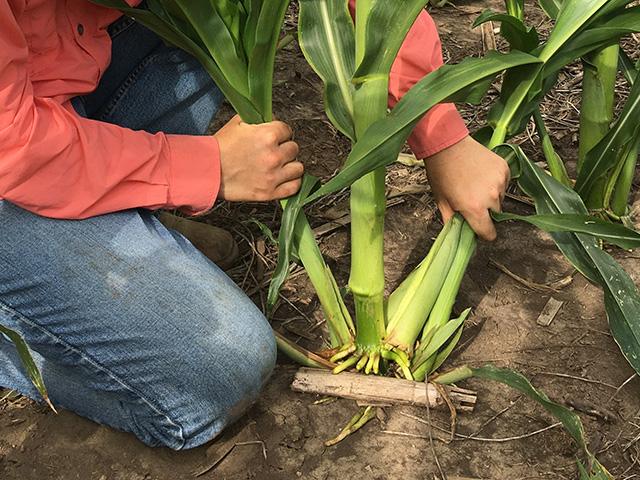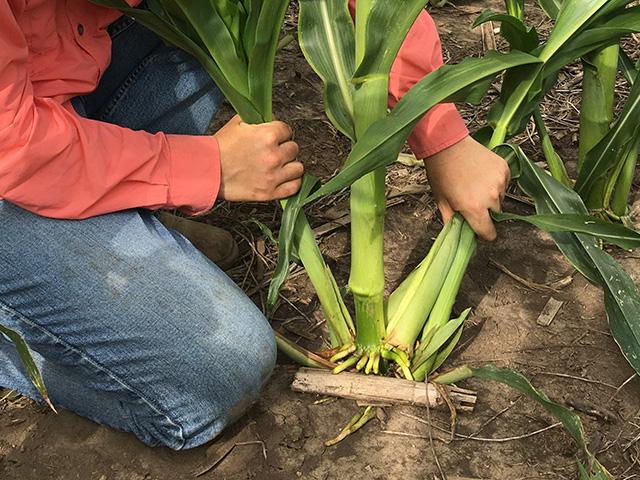Production Blog
Corn Tillers: Yield Killer or Pillar?
JEFFERSON CITY, Mo. (DTN) -- How many stems should a corn plant have? One? Two? Three?
Before you answer, talk to the Tiller Queen.
"Corn is the only grass crop where we only want it to have just one stem," said Rachel Veenstra, assistant professor of crop science at Kansas State University. "Grain sorghum, wheat, rice, millet –- we manage those crops specifically to get more tillers. With corn, we think about it so much differently."
Not only is corn managed differently than other grass crops, but its management also differs based on where it's grown. Corn grown in Kansas isn't grown like corn in Iowa, Illinois or most of the Corn Belt. Water is the primary limiting factor in Kansas, so farmers raising dryland corn take a more conservative approach, reducing seeding rates and plant populations to match the resources available. Sometimes, that leads to more tillering.
"The reason that Kansas farmers plant corn thinner is to save water. When tillers or 'suckers' appear, the common thinking is they're stealing water from the main plant," she said. "Everyone has an opinion, but there really wasn't much research out there on what's happening with those tillers, especially with modern hybrids."
In 2019, Veenstra accepted a graduate research assistantship with K-State cropping systems specialist Ignacio Ciampitti and began tackling tillers on a project supported by Corteva Agriscience and the Kansas Corn Commission. As she began to share some of her work on social media, she soon earned a new moniker.
P[L1] D[0x0] M[300x250] OOP[F] ADUNIT[] T[]
"On Twitter, farmers started calling me the 'Tiller Queen,'" she said. "I just kind of went with it. I don't know if it's something to be proud of or ashamed of, but it's stuck. People might not know my name, but they know my research."
Following her "coronation," Veenstra explored the yield effect of tillers on Kansas corn for three years. At 17 locations across the state, she planted two different corn hybrids at three different plant populations -- 10,000, 17,000 and 24,000 plants per acre. In half of the plots at each site, tillers that developed were removed by hand. Tillers in the other plots were left intact. The corn was taken to harvest, and yields were compared.
"Regardless of the location, plant density or the hybrid, we never saw any yield reductions because of tillers," Veenstra said. "If tillers didn't put on grain, they were able to support the grain elsewhere on the plant. The plant could move nutrients and energy resources from the tillers to the ear on the main stalk -- almost like the tillers were functioning like a bank. Our research supports this theory."
The researcher concluded that corn plants will put on tillers early in the season when resources such as water, light and nutrients are available in greater quantities than can be used by a single stalk. Later in the season, if the plant runs low on any of these resources, it can cannibalize what it needs from its tillers.
"A corn plant that's putting on tillers, well that's just a very, very happy corn plant," she said. "If you see tillers, don't panic."
While tillers didn't hinder yield and, in some cases, helped contribute to it, the extra stems didn't reliably put on grain. Optimizing plant populations for field and growing conditions is still the best management solution, Veenstra said. Water also continues to be a concern when resources are critically low.
"We don't really know what those tillers are going to do," she explained. "Are they going to put on ears, and if they do, will they be normal ears? Tillers have a nasty habit of putting on tassel ears, which are just bad news. They're exposed and a free buffet to whoever wants it."
Now on the faculty at K-State, the Tiller Queen has no plans to abdicate her throne. While her appointment is primarily teaching and advising, she plans to continue conducting field-based crop research -- and that may include corn tillers.
"We don't have a formula to predict if a tiller is going to put on a tassel ear or not," she said. "We have plenty of data, so I would like to get to that down the road."
A summary of Veenstra's research can be found here: https://bookstore.ksre.ksu.edu/…
For more information, visit her website here: https://rveenstra.wixsite.com/…
Jason Jenkins can be reached at jason.jenkins@dtn.com
Follow him on Twitter @JasonJenkinsDTN
(c) Copyright 2023 DTN, LLC. All rights reserved.






Comments
To comment, please Log In or Join our Community .